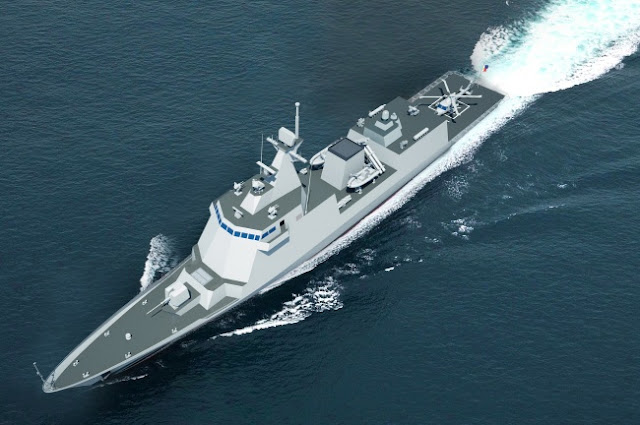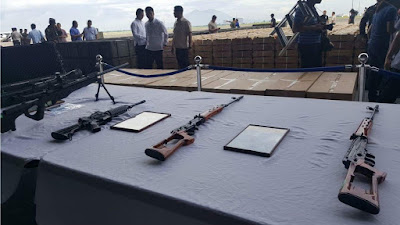The Department of National Defense, specifically its head Defense Sec. Delfin Lorenzana, has admitted in his statement yesterday 20th December 2017, that the reason why he relieved Vice Admiral Ronald Joseph Mercado as the Philippine Navy's Flag Officer in Command (FOIC), was because VAdm. Mercado was in conflict with the Defense Department's orders to proceed with Hyundai Heavy Industry's insistence to use the Hanwha Systems Naval Shield Combat Management System for the Frigate Acquisition Project (FAP). There are many sources online but readers may refer on the clickable links HERE, HERE, and HERE.
It was stated in many reports, and in MaxDefense Philippines Facebook page posts that VAdm. Mercado was indeed in favour of using the Thales Nederland TACTICOS Combat Management System, which both the DND and Hyundai are not in favour to use.
But it was made to appear in reports that VAdm. Mercado was the only one insisting on the use of Thales TACTICOS.
But in the first place, how did Thales come into the picture of the Frigate Acquisition Project? Did Thales just suddenly came out of nowhere and became VAdm. Mercado's preferred supplier in an instant? Who brought in Thales in the first place?
MaxDefense would like to clarify this misrepresentation of the issue.
First of all, Thales Nederland came into the picture because Hyundai Heavy Industries was the one who brought them into the project. Among those submitted by HHI during the 2nd Stage Submission and Opening of Bid Envelopes (SOBE) last December 2015 was a proposal to use a Thales combat management and sensor suite for the future PN frigates, as indicated in their Baseline Configuration List submission.
As MaxDefense discussed as early as October 2016 in the blog entry "Finally, the Contract Signing for 2 New Light Frigates between Philippine Navy and Hyundai Heavy Industries", MaxDefense already mentioned the subsystems approved by the Philippine Navy for the frigates, and it includes the Thales Nederland TACTICOS Combat Management System. The PN's FAP Technical Working Group (TWG) was the one who insisted the use of Thales TACTICOS. The list MaxDefense provided in that blog entry came directly from the Baseline Configuration List submitted by Hyundai last December 2015 to the DND's Bids and Awards Committee and did not just came out of nowhere.
For further reference, even India's Garden Reach Shipbuilders & Engineers (GRSE) submitted a full Thales Nederland combat management and sensor suite which is more comprehensive than those submitted by Hyundai.
So it was not VAdm. Mercado nor the Philippine Navy who brought in Thales into the project. It was Hyundai. So why did Hyundai, and even GRSE, brought in Thales into the project?
That is because Thales' products were compliant to the project's Technical Specifications, which was confirmed by the PN's Technical Working Group for the Frigate Acquisition Project. So why did Hyundai offered Thales only to backtrack later on when the contract was already awarded to them? Is this a case of "Bait and Switch" which, as many in the defense industry know, the Koreans are very well known of doing?
Evidence can be seen below on the position paper submitted by the Philippine Navy to higher authorities showing that the PN FAP TWG "sustained its preference of TACTICOS" for a number of reasons, mostly because Hanwha Naval Shield did not meet the project's Technical Specifications. For the record, this position paper was made in early 2017 when the contract was already signed and the Critical Design Review (CDR) already happening (hense, the FAP PMT Chairman position and not TWG which only applies before project starts), and did not come from VAdm. Mercado, but MaxDefense will reveal further details soon.
VAdm. Mercado's insistence to use the Thales TACTICOS has basis, being the one chosen by the PN's Technical Working Group since 2016, and according to further position papers submitted by the PN's Techical Inspection and Acceptance Committee (TIAC) and Project Management Team (PMT) which succeeded the TWG after the project proceeded with the Critical Design Review last January 2017, shows that the PN did not deviate from its position and still continued to insist on the use of Thales TACTICOS CMS.
VAdm. Mercado's position has legal basis, and has complete black and white documentation. Any investigation on the issue can easily see these evidences if investigators just request for a copy from the Philippine Navy.
MaxDefense will discuss more about the issue in future blogs.
Also, may I take this opportunity to inform everyone that there is a fake MaxDefense Philippines Facebook page that copied the cover photo, profile photo, group name, and even the layout of our page. The difference with this fake group and the original one is that our membership is more than 82,000 people, while the fake one was at 14 people as of this noontime. It also comments on Facebook regarding the FOIC relieving and frigate issues with an opposite stand to ours.
Thank you for your continued support of MaxDefense in uncovering the truth.
It was stated in many reports, and in MaxDefense Philippines Facebook page posts that VAdm. Mercado was indeed in favour of using the Thales Nederland TACTICOS Combat Management System, which both the DND and Hyundai are not in favour to use.
But it was made to appear in reports that VAdm. Mercado was the only one insisting on the use of Thales TACTICOS.
But in the first place, how did Thales come into the picture of the Frigate Acquisition Project? Did Thales just suddenly came out of nowhere and became VAdm. Mercado's preferred supplier in an instant? Who brought in Thales in the first place?
MaxDefense would like to clarify this misrepresentation of the issue.
First of all, Thales Nederland came into the picture because Hyundai Heavy Industries was the one who brought them into the project. Among those submitted by HHI during the 2nd Stage Submission and Opening of Bid Envelopes (SOBE) last December 2015 was a proposal to use a Thales combat management and sensor suite for the future PN frigates, as indicated in their Baseline Configuration List submission.
As MaxDefense discussed as early as October 2016 in the blog entry "Finally, the Contract Signing for 2 New Light Frigates between Philippine Navy and Hyundai Heavy Industries", MaxDefense already mentioned the subsystems approved by the Philippine Navy for the frigates, and it includes the Thales Nederland TACTICOS Combat Management System. The PN's FAP Technical Working Group (TWG) was the one who insisted the use of Thales TACTICOS. The list MaxDefense provided in that blog entry came directly from the Baseline Configuration List submitted by Hyundai last December 2015 to the DND's Bids and Awards Committee and did not just came out of nowhere.
For further reference, even India's Garden Reach Shipbuilders & Engineers (GRSE) submitted a full Thales Nederland combat management and sensor suite which is more comprehensive than those submitted by Hyundai.
So it was not VAdm. Mercado nor the Philippine Navy who brought in Thales into the project. It was Hyundai. So why did Hyundai, and even GRSE, brought in Thales into the project?
That is because Thales' products were compliant to the project's Technical Specifications, which was confirmed by the PN's Technical Working Group for the Frigate Acquisition Project. So why did Hyundai offered Thales only to backtrack later on when the contract was already awarded to them? Is this a case of "Bait and Switch" which, as many in the defense industry know, the Koreans are very well known of doing?
Evidence can be seen below on the position paper submitted by the Philippine Navy to higher authorities showing that the PN FAP TWG "sustained its preference of TACTICOS" for a number of reasons, mostly because Hanwha Naval Shield did not meet the project's Technical Specifications. For the record, this position paper was made in early 2017 when the contract was already signed and the Critical Design Review (CDR) already happening (hense, the FAP PMT Chairman position and not TWG which only applies before project starts), and did not come from VAdm. Mercado, but MaxDefense will reveal further details soon.
VAdm. Mercado's insistence to use the Thales TACTICOS has basis, being the one chosen by the PN's Technical Working Group since 2016, and according to further position papers submitted by the PN's Techical Inspection and Acceptance Committee (TIAC) and Project Management Team (PMT) which succeeded the TWG after the project proceeded with the Critical Design Review last January 2017, shows that the PN did not deviate from its position and still continued to insist on the use of Thales TACTICOS CMS.
VAdm. Mercado's position has legal basis, and has complete black and white documentation. Any investigation on the issue can easily see these evidences if investigators just request for a copy from the Philippine Navy.
MaxDefense will discuss more about the issue in future blogs.
Also, may I take this opportunity to inform everyone that there is a fake MaxDefense Philippines Facebook page that copied the cover photo, profile photo, group name, and even the layout of our page. The difference with this fake group and the original one is that our membership is more than 82,000 people, while the fake one was at 14 people as of this noontime. It also comments on Facebook regarding the FOIC relieving and frigate issues with an opposite stand to ours.
Thank you for your continued support of MaxDefense in uncovering the truth.












































